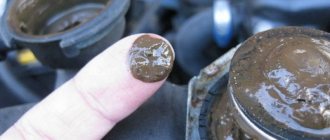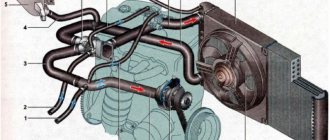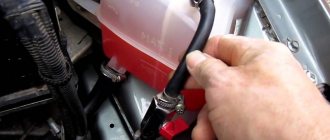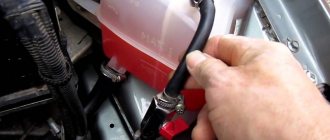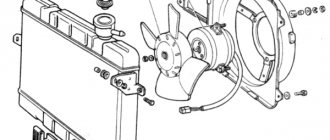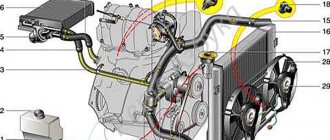Flushing the VAZ cooling system
Coolant replacement
Preparation for work:
To drain the coolant you will need:
After all the coolant has drained out of the system, screw the plugs into the cylinder block and radiator. To prevent air locks from forming as the system is filled with coolant (the coolant will not completely fill the system), you should:
Fill the engine cooling system by pouring coolant into the expansion tank until the level is at the top edge of the expansion tank mounting belt. Close the expansion tank cap.
Warning When the engine is running, monitor the coolant temperature according to the gauge. If the arrow moves to the red zone and the fan does not turn on, turn on the heater and check what kind of air flows through it:
How to remove an air lock in the engine cooling system
remove the air lock by driving the front wheels onto a hill and letting the engine run at medium speed for a couple of minutes. If this does not help, then use the following instructions:
Cleaning the engine cooling system
To clean the cooling system . It is enough to carry out the coolant replacement procedure, but instead of antifreeze, fill the cooling system with fresh water (add a flushing additive if desired), or a special flushing fluid (for example, Hi-Gear). After the engine has been running for some time, drain the liquid from the system along with the dirt. We repeat the procedure as many times as possible until all the dirt is removed from the system.
To completely flush the engine cooling system . need to:
Lada Kalina Hatchback Pipette › Logbook › Cleaning the radiator
Hi all! I have a problem - the cooling fan often turns on and gets hot when the air conditioner is on. I only had 2 options, either a pump or a dirty radiator.
So I decided to wash the radiator first.
I removed the bumper (I didn’t take pictures of the process, I forgot)
The first thing that caught my eye was the unscrewed bolt on the fan (apparently due to vibration)
I took off this same fan and fucked it!
I washed it with simple shampoo and water from a hose. The washing took about 20 minutes, and all these 20 minutes dirt flowed out! Well, actually the result:
Result: It stopped heating, the pump is fine. Happy as an elephant! Beaver everyone))
We flush the engine cooling system on a VAZ-2114 with our own hands: how and with what?
Probably, many motorists have encountered the fact that the car’s cooling system became clogged and required cleaning. So, on the VAZ-2114 it periodically requires this process to be completed. But not all car enthusiasts are able to perform this action with their own hands. This article tells you how to flush your cooling system yourself.
The video below discusses the most basic methods and means for flushing the cooling system on modern cars:
The video will tell you how to clean the cooling system with your own hands and what you will need for this.
How to avoid radiator contamination
It will not be possible to completely isolate the radiator from dirt. All a car enthusiast can do is to ensure that the radiator does not become clogged for as long as possible. This can be achieved in the following ways:
So, anyone who wants their car to run properly must keep the radiator clean. No special skills are required to wash it. All you need is an open-end wrench and a suitable detergent.
Source
Cooling system design
In order to clean the cooling system, you need to understand what elements it consists of and where the coolant flows.
So, let's look at how the VAZ-2114 engine cooling system works:
Schematic diagram of the engine cooling system
1 – element in the form of a plug for the expansion tank; 2 – expansion tank; 3 – hose for draining liquid from the pipe; 4 – hose passing between the radiator and the expansion tank; 5 – hose leading from the radiator; 6 – tank to the left of the radiator; 7 – aluminum tube; 8 – plug systems; 9 – tank to the right of the radiator; 10 – drain plug; 11 – middle of the radiator; 12 – casing for electric fan; 13 – plastic wings of the electric fan; 14 – electric motor; 15 – toothed pump pulley; 16 – pump impeller; 17 – camshaft drive belt; 18 – engine block; 19 – pump pipe; 20 – radiator hose with supply function; 21 – heater radiator hose with drain function; 22 – hose supplying coolant to the throttle pipe; 23 – exhaust pipe; 24 – hose for refilling; 25 – heater radiator hose with supply function; 26 – thermostat; 27 – coolant temperature sensor; 28 – coolant level indicator sensor.
When flushing is necessary
Dirt that flows from the cooling system pipe
Everyone understands that the cooling system, especially in the radiator part, can become clogged. This is due to the fact that the operating temperature of the liquid is quite high and it gradually loses its chemical and physical properties.
Thus, it causes residues to settle on the walls of metal tubes, of which there are plenty in this system. But, despite such a difficult diagnosis, it is possible to cope with it.
Filling liquid to flush the cooling system
It is quite simple to track contamination of the cooling system - the engine gets very hot even in severe frosts.
Consequences of a dirty cooling system
The appearance of the coolant seems to hint
Further, a major overhaul of the head may follow, during which it will be necessary to grind the plane, as well as change the main spare parts.
But this is not the whole process of engine destruction due to overheating. If coolant gets into the main power unit, or rather into the cylinders, a water hammer will occur, which will completely disable it.
Methods for cleaning the cooling system
During operation of the cooling system, two most suitable flushing methods were identified:
External radiator cleaning with water
Cooling System Flush
We’ve sorted out the methods for flushing the cooling system, and it’s worth moving on to the question of what can be used to flush this unit.
How to flush the cooling system (basic products)
At first glance, everything seems quite complicated, but in reality it is not so. There are several ways and means to flush the cooling system. So, let's consider all the possible options for performing the operation, as well as the means by which this can be done.
Replacing the thermostat on Kalina
The thermostat is one of the most important elements of the cooling system of an internal combustion engine. It is designed to regulate the direction of movement of the coolant (coolant) depending on the degree of its heating.
When starting a cold engine, a working thermostat is closed, which forces the coolant to move in a small circle without passing through the cooling radiator. This is necessary so that the engine heats up faster.
When the coolant temperature reaches 85-90 degrees, the thermostat valve will open and antifreeze or antifreeze will flow into the radiator for cooling.
Thermostat malfunctions
The design of the thermostat consists of a housing with pipes and a sensitive element with a valve, which actually shuts off the pipeline. The housing itself fails extremely rarely, and only due to mechanical damage.
Most often the sensitive element breaks. It is a sealed cylinder filled with a wax-based solid. The cylinder contains a piston with a rod. When heated, the substance melts and expands, pushing the piston. The latter extends and closes the valve.
The most common reasons for thermostat failure are:
- deposits of products of corrosion processes on the moving parts of the sensitive element;
- dirt, scale or foreign objects entering the thermostat housing;
- poor quality coolant;
- malfunction of the water pump (pump).
One symptom of a faulty thermostat is an overheating engine. It indicates that the coolant (coolant) moves in a small circle without passing through the radiator. It can also happen the other way around, when the liquid moves constantly in a large circle. In this case, the engine will take a very long time to warm up.
Verification methods
There are two ways to determine the functionality of the thermostat. The first method involves checking without dismantling. To do this, you need to start a cold engine, warm it up to operating temperature (about 90 degrees), and touch the lower radiator hose.
A cold lower pipe at this temperature indicates that for some reason the thermostat did not open. If it is hot, the thermostat operates normally.
For a more accurate check, you will need to remove the thermostat cover with the sensitive element. Place it in a metal container with clean cold water and place it on the stove to warm up. When the water temperature reaches 85-90 degrees, the element should operate, pushing the valve stem forward. If this does not happen, the thermostat is faulty.
Thermostat price
The approximate price of a thermostat cover with a sensitive element in our stores is 450 - 700 rubles. When choosing a spare part, it is better to give preference to branded VAZ models. The catalog number of the Lada Kalina thermostat is 1118-1306010.
The cost of replacing this unit ranges from 500-800 rubles.
In order not to overpay for the work, you can replace the thermostat yourself, but before that, do not forget to check it using the method described above with heating water.
Replacement
Required tools and tools:
- container with a wide neck with a volume of at least 5 liters;
- open-end or socket wrench 13;
- hex key 5;
- screwdriver with Phillips bit;
- clean rag.
1. Having placed the car on an overpass or in a car pit, raise the hood and disconnect the negative terminal on the battery.
2. Open the filler cap on the radiator and the cap on the expansion tank.
3. We move under the car, find a drain plug in the form of a 13 bolt on the bottom of the cylinder block. Place a container under it, unscrew it, and wait until all the coolant has drained. After this, tighten the plug.
4.Remove the air filter housing.
5. On the right side of the block head we find the thermostat. Using a screwdriver, loosen the clamps of the thermostat pipes. We remove all hoses. Use a rag to remove any remaining coolant.
6.Use a 5mm hexagon to unscrew the three screws securing the thermostat cover.
7.Remove the non-working thermostat.
8.Check the integrity of the rubber seal. If there are signs of damage on it, we replace it with a new one.
9. Install a new thermostat. We connect the hoses and clamp the clamps of their fastenings, having previously lubricated the joints of the hoses with sealant.
10.Fill with coolant.
Bottom line
Now we check whether we did everything correctly and how the new thermostat works. We start the engine and let it warm up to operating temperature. We touch the lower pipe, determining its temperature. If it is hot, then the thermostat is working as it should.
Do not forget to check the tightness of the connections between the pipes and the thermostat housing.
Communities › VAZ: Repair and Modification › Forum › Flushing the cooling system
Before washing with CO, you need to understand that there can be (and as a rule there are) 2 types of contaminants in the system: - fats or similar liquid... - scale, that is, salts... I think that most companies that produce shit... such as additives for washing do business and act according to system, pills do not get rid of the disease, but heal until the next relapse...
Fats or similar slurry are not butter or sunflower oil, or even worse, motor oil, but chemical additives in the coolant that have used up their resource and precipitated in the form of a thick slurry that can be wiped off with your finger.
Scale, that is, salt, is nothing more than a limestone deposit that you can see on your kettle. it can be of different colors depending on the age of the car and the quality of the coolant being poured.
As a rule, fats are located on top and scale on the bottom. Therefore, I think and tried to wash it like this (the result satisfied me): 1. I drained all the crap... that was in the CO. 2. Filled with distillate + alcohol (Ethanol and only pure Ethanol, fill in METHANOL ass... it’s all aggressive) in a ratio of 1l/100ml. 3. Started the engine and ran for maybe an hour and a half. 4. I poured out the grayish-brown turbidity. 5. I filled it with pure distillate without alcohol and started it again and the engine ran for maybe an hour and a half. 6. I drained the cleaner dregs and again poured in distillate, this time clean without alcohol, and started it again and the engine ran for maybe an hour and a half. 7. It is necessary to wash until the water is completely clean. 8. I waited until it cooled down (this is important), poured out the clean warm distillate and diluted citric acid in a ratio of 1 l/10 g in it. 9. I filled it back up and the engine ran for maybe an hour and a half (more depending on the contamination). 10. then the same procedure as after alcohol...
Instead of lemon juice, you can use lactic or acetic acid.
Do not wash with cola; it is aggressive and is only suitable for unscrewing the nuts on the manifold. If you decide to have drinks, then a sprite is better and, at worst, a forfeit...
Everything is fine with me. Denis.
buy RYAZHENKA, fill it up and ride with it at least 51 km))) you can do 52 km... drain it, fill it with antifreeze and you will be happy
I washed it like this: I drained the old antifreeze trace. method: 1. disconnect the lower pipe from the radiator (/or unscrew the drain plug) 2. disconnect the pipe from the thermostat. 3. start. the temperature will rise very quickly. I think I turned on the stove and waited for everything to drain completely (a quick process). 4. I close everything, fill in the cooling system flush + distilled water, warm it up well until the fan turns on twice. Also turn on the stove for cleaning. 5. merge everything as in the first three points. 6. Pour in distilled water, heat it up and again drain everything. 7. fill in clean antifreeze and go.
If there are bad pipes, POSSIBLY (I have not seen this) a leak may appear from the cooling system cleaner. Be prepared for this. Good luck!
I washed 5 lemon bags with citric acid in 10 liters of water, all the scale fell out in pieces, even the radiator started working =)
Participate in the discussion can only registered users.
Source
Flushing the engine cooling system.
Antifreezes generally have a service life of 5 years or until the engine travels 250 thousand km. Antifreeze has a service life of 2-3 years. By the way, you can see what happens if you mix antifreeze with antifreeze. Depending on the operation of the vehicle and the quality of the coolant, if the coolant is not changed or if the coolant is diluted, the radiator channels and cooling jacket become clogged. Therefore, to increase the overhaul life of the engine, it is necessary to periodically flush the engine cooling system. You can wash it both in car services and at home in your own garage.
Need for cleaning
Car owners use current flushing methods in practice when identifying channel contamination and before completely replacing antifreeze. In a cooling system, connecting pipes are considered to be the most vulnerable to clogging. Due to contamination, the channels become clogged and eventually collapse under stress. The main contaminant of the ducts is the scale of salts formed as a result of high-temperature exposure. It grows on the inner surface of the tubules and reduces the bore diameter. If it is not removed, the efficiency of the system is significantly reduced, the motor overheats and may fail. The degree of overheating is indicated by a burning red light indicator on the dashboard. You can get rid of contaminants using distilled water in the following way:
Flushing the engine cooling system yourself.
The products used to flush the engine cooling system use both special chemicals and folk ones. Folk remedies for cleaning the system are inexpensive and proven many times. Acid-containing products can remove rust and such deposits, and alkaline products can remove scale.
Consider washing with citric acid.
Since citric acid (formula C6H8O7) is capable of corroding rust and deposits of oxidized metals, it can be used effectively if water was used as a coolant in the engine cooling system.
How to dilute citric acid for flushing radiators:
Follow by flushing the cooling system:
The next common folk remedy for flushing the engine cooling system is acetic acid.
An acetic acid solution effectively removes rust. To prepare the washing solution you will need:
The replacement procedure is the same as using citric acid:
Another folk remedy used as a flushing fluid for all channels of cooling systems is the carbonated drink Fanta.
Fanta contains citric acid.
Therefore, some home craftsmen also use it for cleaning. They drain the old fluid, fill the entire system with this phanta, then let the engine run for about an hour at idle speed, or, if the contamination is severe, then they operate the car with the phanta filled in for a couple of days. Then drain and fill with distilled water, and also operate for two days. Then drain and look at the condition of the liquid. If necessary, carry out the procedure until the drained liquid becomes relatively clean. After flushing, you need to check all the cooling system pipes and the radiator. It happens that rust blocked the holes and the system remained sealed. But after flushing, the radiator or pipes may leak.
Flushing the cooling system with lactic acid or whey.
A less common option is to use whey or lactic acid as a flushing fluid for the engine cooling system.
If lactic acid is available, the entire system is filled with it. Start the engine and allow it to idle or under load for some time.
But not everyone has the opportunity to use lactic acid for washing. Therefore, whey is used instead.
The sequence of flushing the cooling system with serum:
The next folk remedy for cleaning the engine cooling system is caustic soda.
Caustic soda, also known as “caustic alkali”, also known as sodium hydroxide, also known as caustic soda, is an effective remedy, but only for, attention! - copper radiators. It is prohibited to pour soda compounds into aluminum radiators or any other aluminum parts. To use this method and follow the instructions, you will have to remove the radiator.
The manufacturer of copper radiators has developed these instructions for washing with caustic soda:
Application of acids and alkalis
Treatment with clean water is relevant for channels that do not have significant contamination. Most motorists clean problematic cavities using more aggressive agents containing alkaline or acidic compounds. However, it is worth taking precautions when using acids and other chemicals so that their compositions, in concentrated or diluted form, do not damage the cavity.
Citric or phosphoric acid
For internal combustion engines that require cleaning of oil or sealant residues, acid-containing products are used. The sequence is:
- We carefully prepare the solution, since it will be possible to safely flush the engine cooling system with citric acid without negative consequences, observing the proportions at which 10 liters of water and 1 kg are taken. citric acid (if the pollution is of medium intensity, then reduce the concentration to 0.8 kg of lemon juice);
- we get rid of the old antifreeze and pour the prepared mixture into the cooling system of the cooled engine;
- start the engine for 10-15 minutes, then turn it off and let it sit for 40-45 minutes;
- washing is carried out with distilled water three to four times to completely remove acid residues.
You need to stock up on about 20 liters of distillate and not exceed the limit. Otherwise, the aggressive composition will corrode the pipes and connecting hoses. In the same way, wash the canals using vinegar. The proportions are 10 liters. water per 0.5 l. 9% liquid. You need to warm up the engine to 100 0C, then turn it off. We leave the car alone for 9-10 hours, usually overnight. We remove the resulting composition. Before flushing the engine cooling system from rust with distillate, if there is significant contamination, repeat cleaning with vinegar. The disadvantage is the need to wait a long time for cleansing. However, this is compensated by the low cost of the procedure. If the passages are significantly dirty, the process takes several days.
Soda and whey
An experienced motorist often cleans the radiator and stove from scale with caustic soda. The method is relevant only for those models in which the manufacturer has installed copper or brass components. If the system uses aluminum pipes or radiators, then cleaning with caustic is unacceptable. Putting the cooling jacket in order with such a means will be effective if the proportions of the components that make up the solution are observed. Typically, motorists first dismantle the radiator and stove for caustic cleaning. Add 50 grams of soda to each liter of water. The composition copes well even with old salt or corrosive deposits on the internal walls. Since the product is quite caustic, you need to work with it in compliance with safety precautions, using protective gloves. A composition based on lactic acid or whey is gentle in its chemical effect on rubber components. We first recommend passing the liquid through a sieve to get rid of solid particles. Experts recommend driving this train for several hundred kilometers. in a gentle manner. Treatment with fermented milk whey is completed by draining and cleaning with distilled water. The effect is often comparable to the work of popular chemicals. It is permissible to use this technique only in the summer, since the composition will harden at subzero temperatures, causing significant damage.
Alternative options
Many people online suggest using Coca-Cola to clean radiators. There are successful examples of processing. It is worth considering the nuances that include the use of a sugar-free drink. After the infusion at XX, the engine runs for about half an hour, and then we make a trip of 100-120 km. The next step is washing with water and adding antifreeze. The effect is achieved due to the presence of phosphoric acid as a component of Coca-Cola and its analogues. We do not recommend using white for such operations. The sodium hypochloride included in the structure reacts with aluminum, which is especially noticeable with increasing temperature, when the intensity of the interaction increases. Other household chemicals act on pollution as follows:
- Calgon (Calgon) and similar substances perfectly counteract scale salts, minus them in a neutral relation to corrosive residues;
- Mole and other means of cleaning pipes from blockages include caustic in significant concentrations, which is unacceptable for aluminum;
- Fairy (Fairy) is designed to eliminate grease, but in the fight against scale and rust it will be ineffective, and will also require long and thorough cleaning after use.
Usually, improvised means are used when it is not possible to buy a ready-made chemical preparation.
What means are not advisable to flush the engine cooling system?
Coca Cola
Many people know that Coca-Cola can be used to remove scale and clean radiators.
There are many videos on the Internet on using Coca-Cola to clean teapots and other items in which deposits form. Coca-Cola can be used to flush radiators and all channels of the engine cooling system. Coca-Cola contains phosphoric acid, which perfectly removes rust, greasy deposits of oil and additives. But there is one thing. The fact is that in addition to orthophosphorus acid, Coca-Cola contains sugar and a lot of carbon dioxide.
If you chose the Coca-Cola method of flushing the cooling system, then:
Fairy
Some may use this chemical to flush the internal combustion engine refrigeration system, but it’s not worth it. It removes grease perfectly, but does not dissolve rust and other deposits. But with the help of fairies you can perfectly wash the outside of the radiator. During the summer, many flies and other insects stick to the front of the radiator.
Calgon
Products such as calgon and others (Mr. Muscle, Tiret), similar to them, are used to protect against scale formation. It is unlikely to be able to remove rust and deposits. It is better to add it to the washing machine so that scale does not settle on the drum.
White
A powerful product for removing dirt, germs, mold with a pungent, persistent odor. White contains sodium hydrochloride, which can corrode the surfaces of aluminum parts. When heated, the white will quickly corrode aluminum tubes. Therefore, you should not use or experience it yourself.
Mole cleaning agent can only be used in copper main radiators and stove radiators, because it contains caustic soda.
It will ruin aluminum surfaces. It also corrodes rubber seals and seals. After flushing, you also need to be able to fill in new coolant, otherwise an air lock may form. Then you will have to expel this air lock from the system.
Combined method of citric acid, vinegar and soda
There are those who mix various substances in the hope of getting a super solution for flushing the engine cooling system.
Make the following mixture:
Such homemade chemical mixtures may clean the channels in the system, but at the same time they will destroy the rubber seals.
Reasons for poor heater performance
Deposits form on the inner walls of the cooling system elements, which impair the performance of:
This situation cannot last long. The negative impact on almost all components of the machine ultimately leads to serious and expensive repairs. The car heater is no longer able to heat the air in the cabin, and you begin to understand that a clean Kalina stove is simply necessary. Why does this situation happen? The heater radiator stops performing its function:
The internal channels of the radiator become clogged with scale and coolant oxidation products, which makes it difficult for the fluid to circulate. This directly affects the process of heating the interior air.
Conclusion
As you can see, you can effectively flush the engine cooling system yourself, but I recommend using special auto chemical products after reading the instructions first. Traditional methods can also be effective, but who knows, it may not be suitable for your engine.
To drain the coolant Remove the expansion tank cap. Place a container under the engine and unscrew the drain plug on the cylinder block. Place a container under the radiator and unscrew the drain plug on the radiator. After all the coolant has drained out of the system, screw the plugs into the cylinder block and radiator. If you have an injection engine, then loosen the clamp and disconnect the coolant supply hose from the throttle pipe heating fitting. If the engine is carburetor, then disconnect the hose from the carburetor heating fitting.
Fill the engine cooling system by pouring coolant into the expansion tank until the level is at the top edge of the expansion tank mounting belt. Close the expansion tank cap. Reconnect the hose to the throttle body or carburetor heater fitting (depending on engine model). Install the ignition module and the negative battery cable. Start the engine and let it warm up to operating temperature (before turning on the fan).
After this, turn off the engine, check the coolant level, and if necessary, add it to the same level. Warning You can remove the air lock by driving the front wheels onto a hill and letting the engine run at medium speed for a couple of minutes. If this does not help, then use the following instructions: Disconnect the pipe from the remote control (throttle assembly) going to the (return).
Pour coolant into the reservoir. Coolant should flow from the remote control fitting (throttle assembly pipe). If you run, then go straight to point 6.
We start it and close the hose with our finger. We are waiting for the coolant to run from the remote control. Plug the fitting when coolant starts flowing and hold until coolant flows out of the hose.
As soon as it runs, we put the pipe back on (loops it). We warm up the internal combustion engine to operating temperatures and check the stove at idle. If the air blows hot, that means everything, if it’s warm, then we return to 1.
Add coolant to normal level. To completely flush the engine cooling system, you need to: Flush the radiator. To do this, drain the coolant system, then disconnect the hoses from the base and upper radiator tank. Insert a garden hose into the upper radiator hose and run water through the radiator until water comes out clean from the hose at the base of the radiator ( ).
Flush the engine. Insert a garden hose into the thermostat outlet and run water through the motor until water comes out clean from the bottom hose. Flush the heater core.
Open the heater tap and disconnect the hoses from the heater. Connect a hose to one of the fittings and rinse with a stream of clean water until water flows out clean from the other fitting. What is the best way to flush the engine cooling system? Many people refuse plain water and special washing liquids, and choose Sprite or Coca-Cola. You've probably already heard about the wonderful properties of cola, which can clean scale from a kettle or even a toilet.
AVTOVAZ recommends replacing the fluid in the cooling system of the Lada Kalina every 75 thousand km of the vehicle or after five years, whichever comes first. Our illustrated step-by-step instructions will help you complete this procedure yourself.
LADA > Kalina
It is more convenient to replace the coolant when the car is installed on an inspection ditch or overpass.
How to drain all antifreeze from Lada Kalina yourself
Today Lada Kalina is a fairly popular type of vehicle. This brand of car is distinguished not only by high technical performance characteristics, but also by a moderate price category, which helps to increase demand among domestic consumers.
The car is presented on the modern market in three main body styles:
Despite the wide range of existing advantages of such a vehicle, owners often have a question: how to drain antifreeze from Lada Kalina? Is it possible to carry out such an event on your own?
Advantages of the Lada Kalina vehicle
Before you start replacing antifreeze in vehicles, you need to find out what advantages such a unit has
The creators of Lada Kalina paid close attention to various features of the car. This made it possible to create a high-quality unit, equipped with the following options:
- electric power steering;
- centralized lock;
- airbags;
- increased level of vehicle rigidity;
- modernized interior ventilation system;
- wide viewing angle.
The advantage of the Lada Kalina is also considered to be the presence of specialized belts equipped with pretensioners, since such an element complies with existing norms and standards of the highest quality.
Replacing antifreeze Lada Kalina
Western experts at service centers recommend replacing antifreeze in a car at least after every 50 thousand kilometers. Often, before replacing the fluid, the car owner is faced with problems associated with replacing the radiator expansion tank, water pump or thermostat.
Of course, to carry out such actions, it is necessary to drain the coolant. That is why a fairly reasonable question arises: how to drain the antifreeze in a car yourself, without turning to experienced professionals?
Step-by-step instruction
Owners of a LADA kalina car should be aware that before starting to replace antifreeze, you need to know what it is.
Antifreeze, better known as antifreeze, is a coolant for the optimal functioning of all vehicle systems and mechanisms. This liquid does not freeze at extreme temperatures and is diatomic. Professionals recommend replacing antifreeze or antifreeze if the temperature changes.
That is why car owners know that, in principle, water can be used for the summer period
In winter, it is important to pay attention to such a criterion as increased resistance to frost. Professional experts have created step-by-step instructions that will help every car owner change the antifreeze on their own
- Place the unit on the inspection hole;
- Cool the engine;
- Remove the plastic motor boot. This action can be carried out if you use specialized tools;
Remove the hidden plugs for the fog lights;
Unscrew the hidden screw;
- Place a specialized container under the vehicle radiator;
- Unscrew the specialized plug located at the bottom of the radiator;
- Drain the coolant;
Pay close attention to the car engine to drain the fluids from it;
- Place another container under the engine;
- Unscrew the specialized bolt, which is also called a plug;
Drain off the remaining liquid.
After such measures are completed, the drainage of the liquid is considered complete. Now you can start cleaning the system, replacing faulty components, or simply adding fresh antifreeze.
How to drain antifreeze in Kalina
1449660639_2279_4_9a_01zh
We unscrew the plug and drain the coolant from the cylinder block.
We tighten the drain plugs of the radiator and cylinder block. The connection between the plug and the cylinder block uses a conical thread that does not require additional sealing. Tighten the drain plug of the cylinder block to a torque of 25–30 Nm. We pour the fluid recommended by the manufacturer into the engine cooling system through the expansion tank until it is full. Let's start the engine. With the engine running, vigorously compress all the hoses of the cooling system several times in turn - this will help the fluid fill the system and displace air from it. As the coolant level in the expansion tank drops, bring it to normal and screw on the tank cap. When the engine warms up, the outlet (lower) radiator hose should be cold for some time, and then quickly heat up, which will indicate the beginning of fluid circulation in a large circle. After waiting for the cooling system fan to turn on, stop the engine. After the engine has cooled, check the coolant level again and, if necessary, replenish the system.
Source

